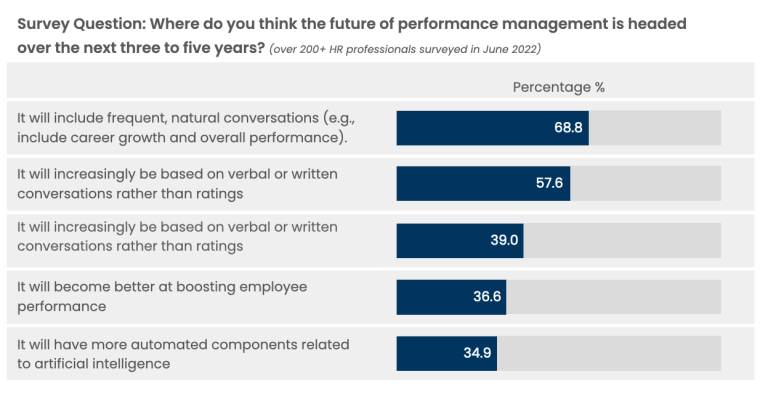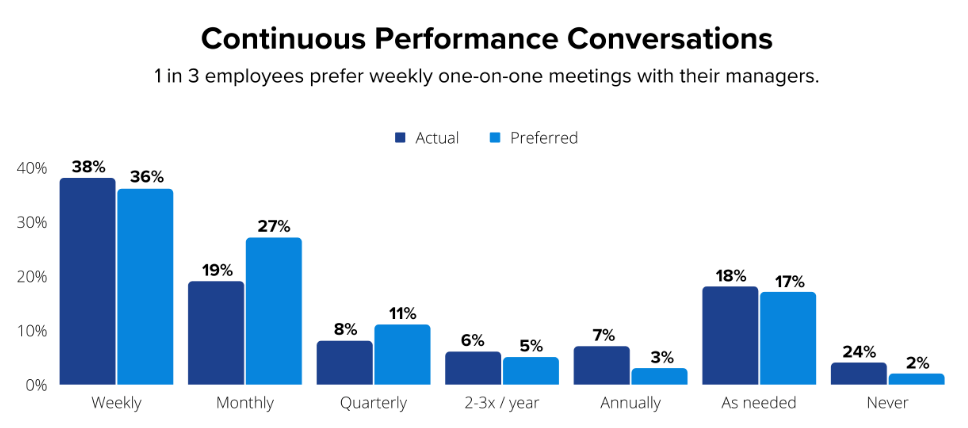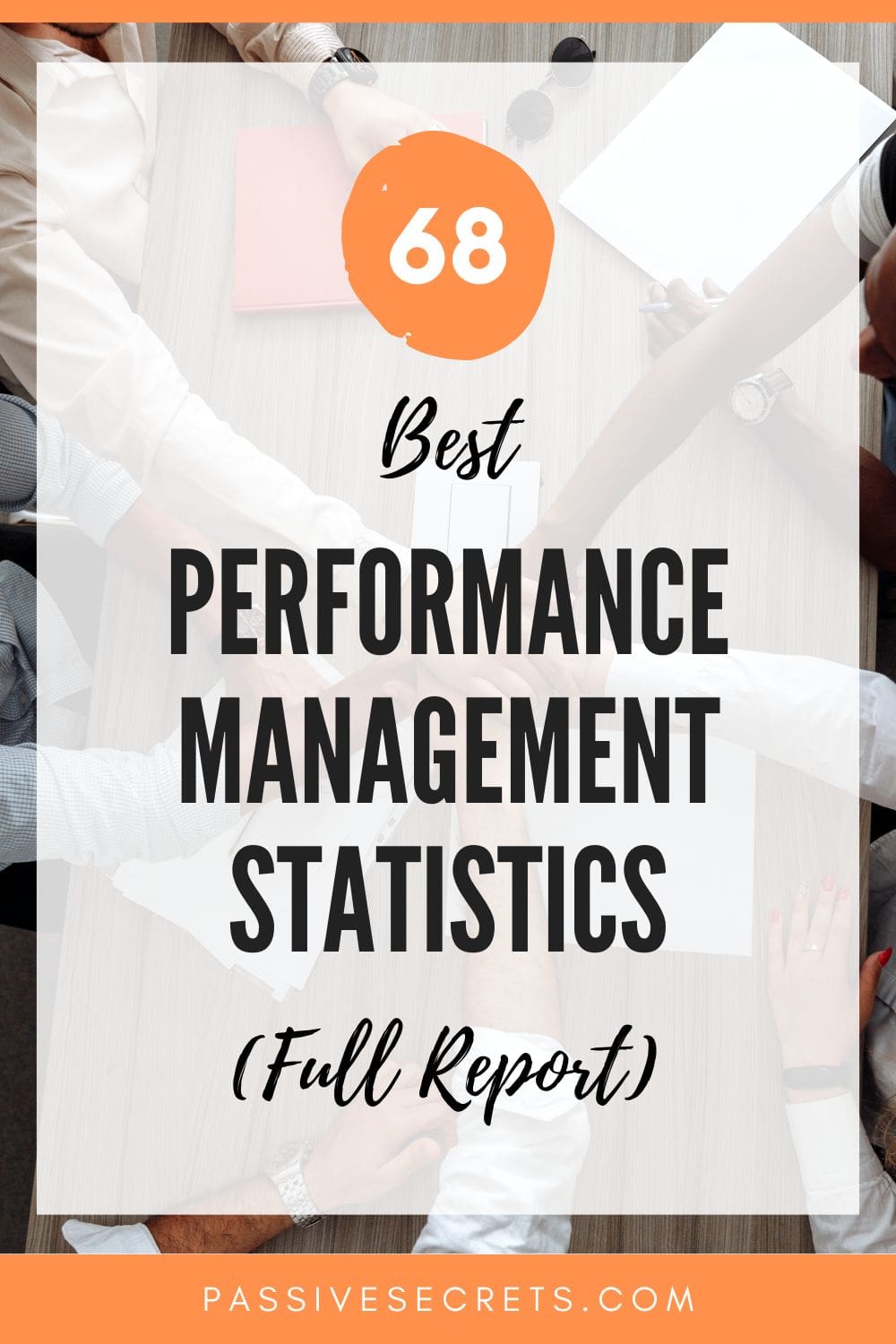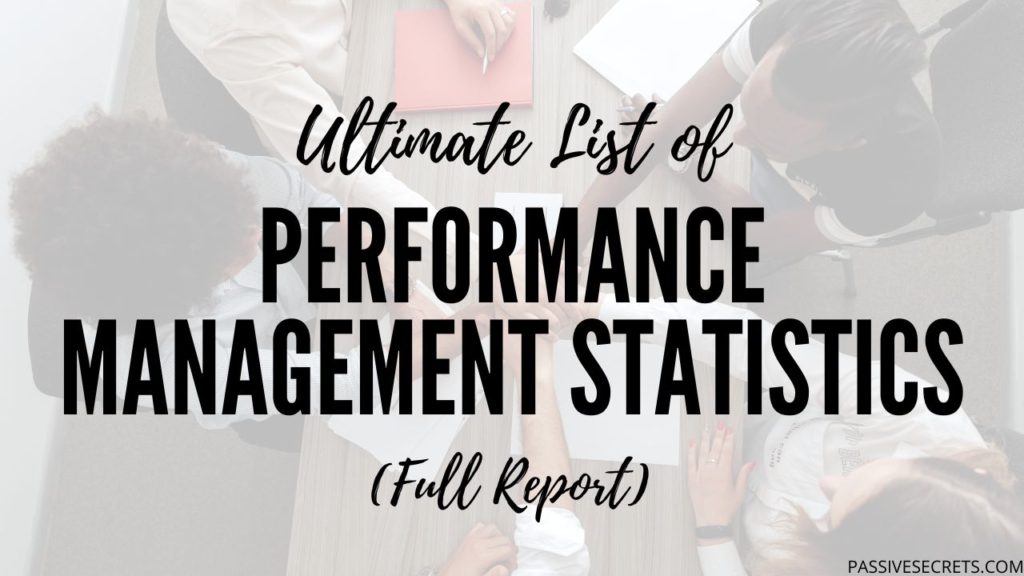
Lack of improvement in any organization is synonymous with failure.
When there are no definite systems to define roles, understand strength, give constructive criticism, and even reward positive behavior, the entire organization is in jeopardy.
The backbone of your company’s performance management process depends on planning, coaching, reviewing, and rewarding.
Companies can create these performance management examples by focusing on setting employee goals and appreciation.
For instance, some companies have a platform where employees can leave notes on a software project if they have new ideas. These new ideas help in the improvement of the task at hand.
Below is curated research that sheds light on performance management statistics.
Key Highlights: Performance Management Statistics
- While 98% of businesses believe performance management is essential, only 64% have a practical approach.
- 70% of organizations believe there should be a better relationship between performance management and other talent considerations.
- 84% of managers agree that burnout needs to be addressed through performance management.
- 81% of HR leaders are making changes to performance management.
- 35% of companies without continuous performance systems failed to implement year-round productivity enhancements.
- Companies adopting continuous performance feedback significantly outperformed the competition at a 24% higher rate.
- Only 14% of employees claim they are motivated by traditional performance reviews.
- Almost all (97%) of Gen Z are open to receiving feedback, with 63% wanting it promptly and constructively throughout the year.
- Companies with continuous performance feedback were 50% more satisfied than those relying on an annual system.
- 37% of employees claim they would put in more effort at work if they received more praise from their leaders and employers
Important Performance Management Statistics
1. In a recent survey, 84% of managers agree burnout needs to be addressed through performance management. (source)
2. According to 70% of the organizations polled, there should be a better relationship between performance management and other talent considerations. (source)
3. Only 50% of the workforce understands job requirements. (source)
4. Managers struggle to complete their reviews on time – as many as 50% of employees’ evaluations were overdue by 30 days or more. (source)
5. Performance management has a really low net promoter score of -60, and there is an urgent need for performance management systems to reverse this. (source)
6. 35% of companies without continuous performance systems also failed to implement year-round productivity enhancements. (source)
7. 14% of employees claim they are motivated by the “performance reviews” that exist in most organizations. (source)
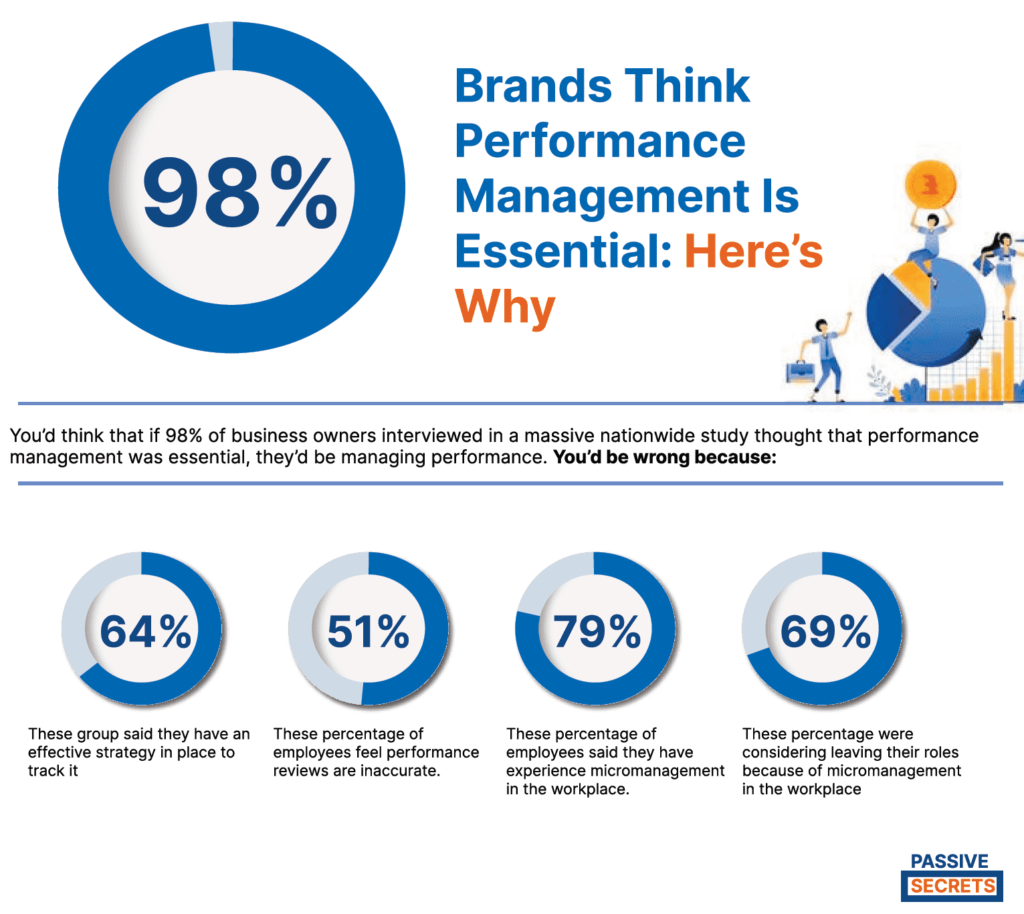
8. 98% of businesses believe performance management is essential, but only 64% say they have a practical approach. (source)
9. 70% of companies say there should be a stronger link between performance management and other talent considerations. (source)
10. Some disadvantages of the traditional appraisal system are lack of efficiency, de-motivation, discouraged teamwork, and inflexibility of the process. It is also very costly. (source)
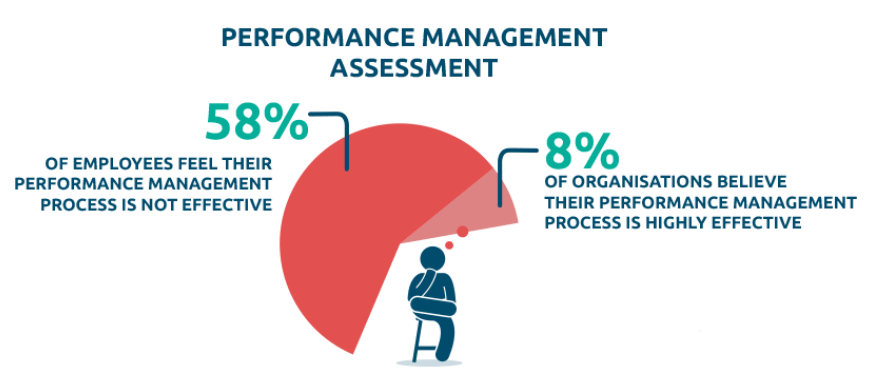
11. Some areas where companies with continuous performance management outperform traditional ones are increased productivity (66%), motivating the entire workforce (65%), and achieving top organizational goals (64%). (source)
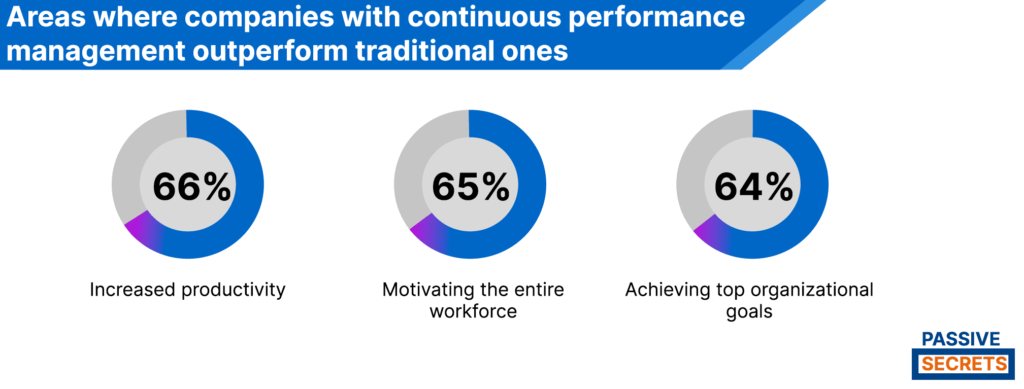
12. 90% of business leaders claim that engaged employees perform better. This means that managers and business leaders have to be intentional about ensuring that their employees are as engaged as possible. (source)
13. Performance appraisals through management dashboards, peer review, and 360-degree feedback have been proven to help employees improve and accomplish the company’s overall goals. (source)
Employee Feedback Statistics
14. Companies adopting continuous performance feedback significantly outperformed the competition at a 24% higher rate. (source)
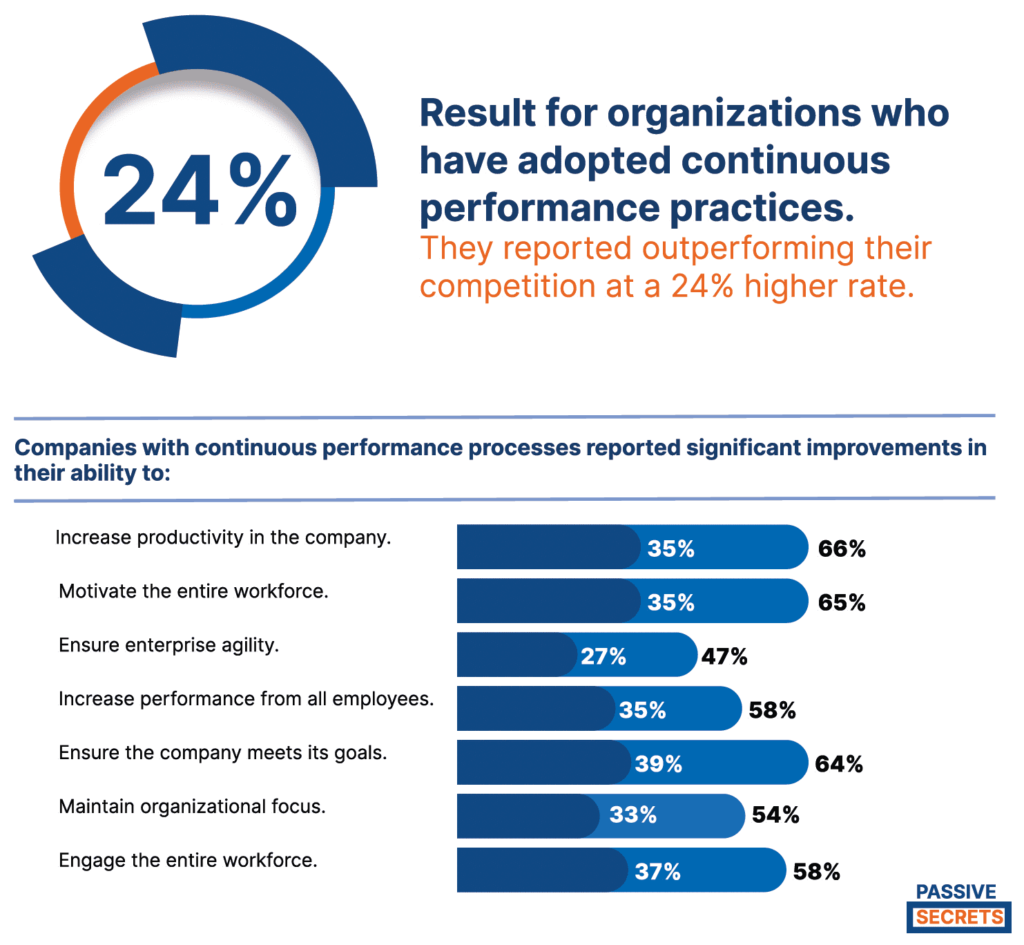
15. 82% of employees say they want to be regarded as people, not just workers in their different organizations. (source)
16. Almost all (97%) of Gen Z are open to receiving feedback, and 63% want it promptly and constructively throughout the year. (source)
17. 65% of employees want more established roles and responsibilities. (source)
18. 63% of employees say they are “thriving” in their current roles. (source)
19. The team members of managers who provide weekly feedback instead of annual are 5.2x more likely to agree that they receive meaningful feedback strongly. (source)
20. Employee engagements help to build trust, purpose, and autonomy within workers and also build some level of oneness on the outside. (source)
21. A survey has shown that 36% of engaged employees are enthusiastic about their jobs and even willing to offer extra efforts to make the business move forward. (source)
22. Around 10% of U.S. workers felt engaged after receiving negative feedback on the job. (source)
23. A survey has shown that 49% of unengaged employees are relatively satisfied with their jobs. However, they were not so committed and would not go out of their way to get anything done. (source)
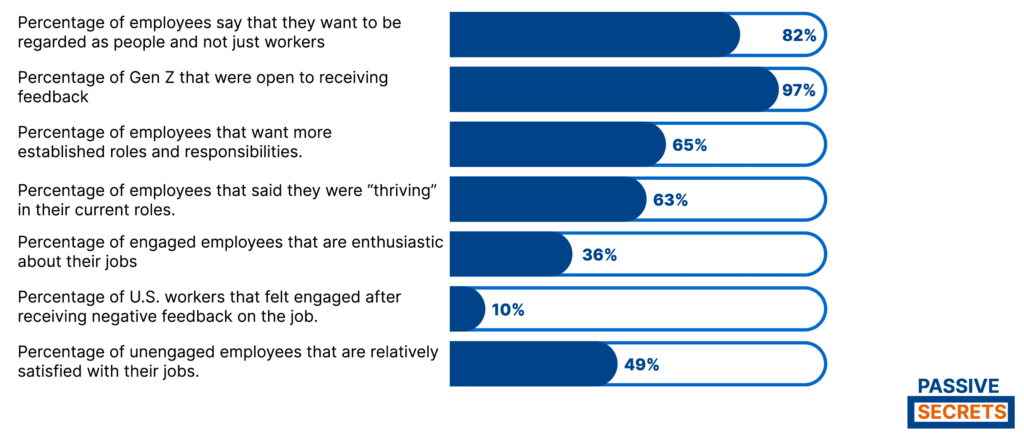
24. 30% of workers are so discouraged by negative feedback that they actively seek new employment. (source)
25. A survey showed that 15% of disengaged employees always complained to their co-workers and did not maintain the office culture. (source)
26. 75% of employees who receive feedback from their employers claim that it went a long way in influencing their success at work. (source)
Performance Appraisals Statistics
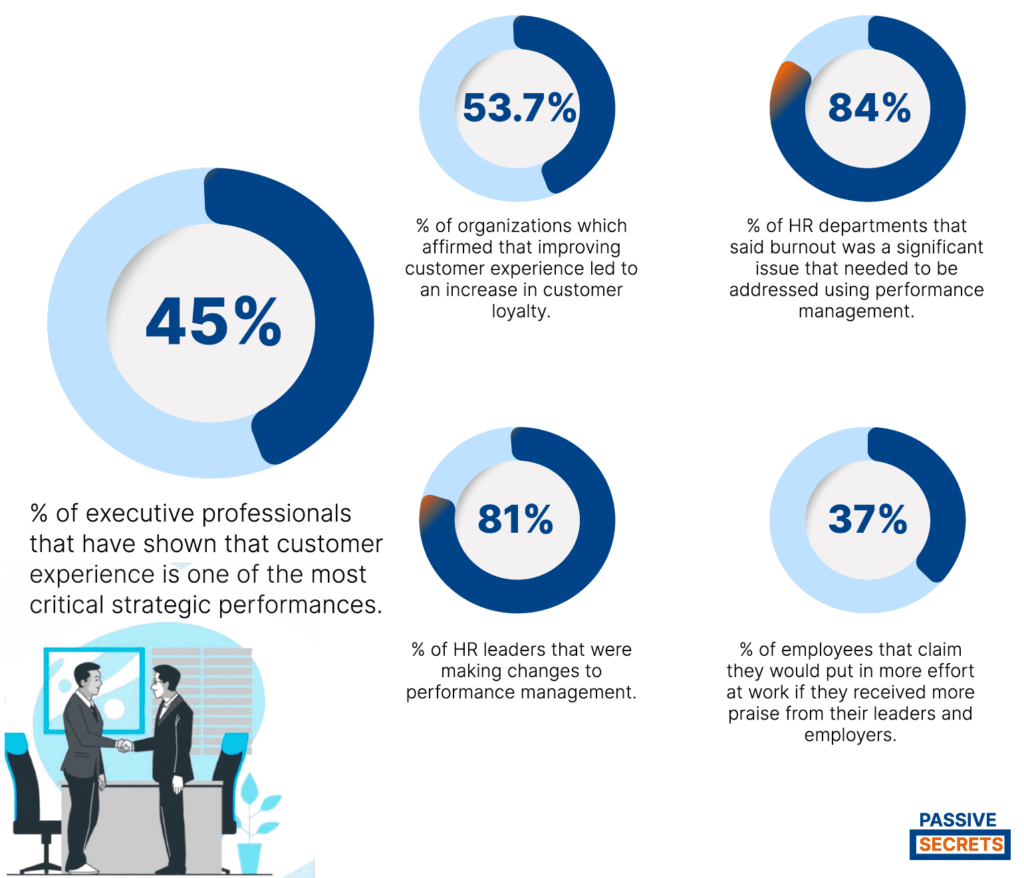
27. 45% of executive professionals have shown that customer experience is one of the most critical strategic performances. (source)
28. 53.7% of organizations affirmed that improving customer experience led to an increase in customer loyalty. (source)
29. 84% of HR departments said burnout was a significant issue that needed to be addressed using performance management. (source)
30. 81% of HR leaders are making changes to performance management. (source)
31. 37% of employees claim they would put in more effort at work if they received more praise from their leaders and employers. (source)
32. 29% of organizations that use peer review feedback reported it had the most positive effect when it was ongoing rather than given at certain times of the year. (source)
33. 77% of businesses claim that employee experience has helped too. (source)
Employee Performance Statistics
34. 22% of employees have called in sick rather than face a performance review. (source)
35. About 50% of the workforce understands work expectations. (source)
36. 71% of managers feel employee engagement is one of the most critical factors in overall organizational success. (source)
37. Workplace training and developments have been proven to increase the engagement and efficiency of workers. (source)
39. More than 1 in 5 new hires claim their ongoing experience at various companies has made them question their job choice. (source)
This means that performance management software must be implemented to define the target company’s targets and clearly communicate with new hires.
40. The average company’s most significant productivity losses are often caused by less than 20% of employees who are ‘disengaged’ or ‘extremely disengaged.’ (source)
41. Employee engagement has been proven to have benefits such as an 81% decrease in absenteeism, an 18% increase in productivity, and a 10% increase in customer loyalty. (source)
42. Employee engagement has been shown to reduce theft in organizations by 28% and accidents by 64%. (source)
43. Companies with engaged employees had 89% greater customer satisfaction and 50% higher customer loyalty than their disengaged counterparts. (source)
44. Employees who find passion and purpose at work are more than 3x as likely to stay with their organizations as those who don’t. (source)
45. 22% of remote workers claim it is hard to unplug after work. (source)
46. 48% of employees with flexible work options say their work-life balance is excellent or perfect (compared to 36% of in-office workers), and 54% of flexible workers say they have the emotional support they need (compared to 45% of in-office workers). (source)
47. 1 in 3 employees cites boredom as the main reason for leaving the workplace. (source)
48. 81% of employees feel at risk of burnout in 2022. This is an increase from 63% in 2019. (source)
49. In a survey in 2021, only 65% of employees felt engaged in their work. (source)
Performance Review Statistics
50. 63% of companies still give annual performance feedback. (source)
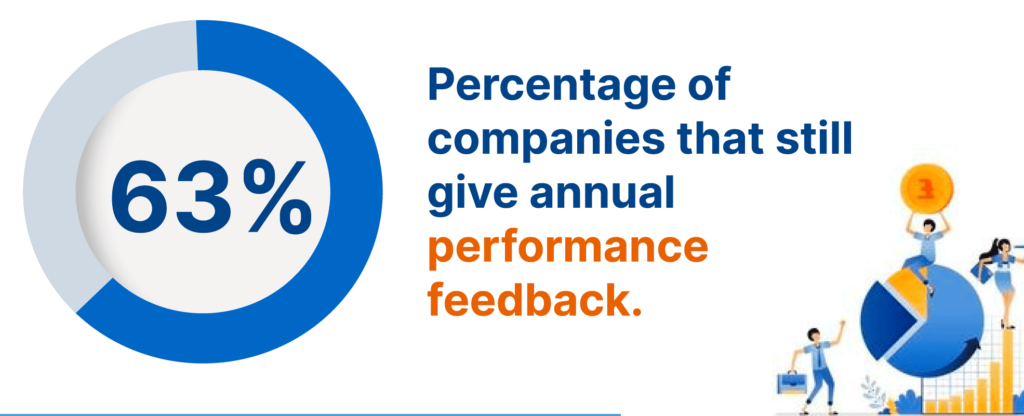
51. 10% of managers spend a lot of time ensuring there is a set-out policy for performance management. (source)
52. HR teams with a continuous performance program are 50% more satisfied than those in companies that rely on an annual system. (source)
53. 85% of employees who receive weekly performance reviews are more engaged. (source)
54. Organizations with continuous performance processes are 39% better at attracting top talent and 44% better at retaining talent. (source)
55. 95% of HR leaders felt unhappy with traditional performance reviews. (source)
56. Companies and organizations with greater-than-average employee engagement reported 27% higher earnings and 38% higher productivity. (source)
57. Only 5% of HR managers are satisfied with performance reviews. (source)
58. 59% of employees think traditional performance reviews have “no impact” on their personal performance. (source)
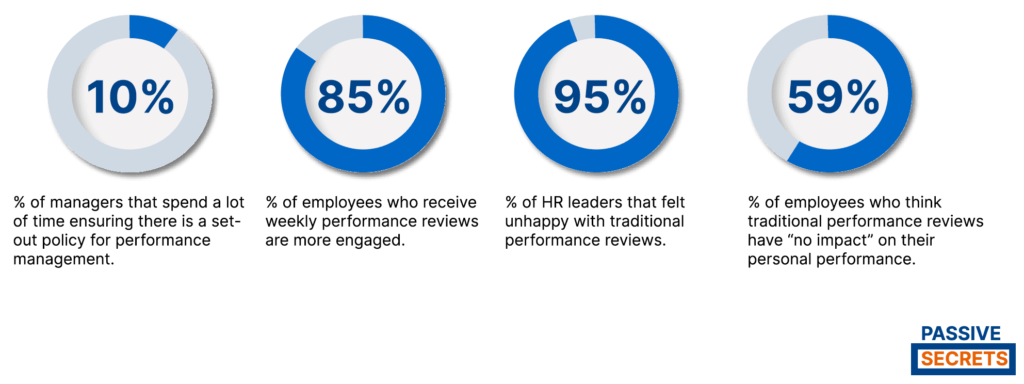
59. 47% of HR leaders are unaware of employee skill gaps, and 60% claim that building skills and competence will be a top performance management priority. (source)
60. 47% of millennials started looking for a different job after receiving their performance review. (source)
61. The use of annual review systems decreased from 82% in 2016 to about 54% in 2020. This value is said to keep declining as progress is made over the years. (source)
62. Research has shown that most managers delay up to 50% of workers’ reviews for up to 30 days. (source)
63. The two main concerns with traditional performance reviews are that the effort is too high (time-consuming, complex) and the usefulness is too low (inaccurate, unmotivating). (source)
64. 49% of HR leaders are unprepared for emerging performance and management needs. (source)
65. 85% of employees who have weekly check-ins with their managers have also experienced higher employee engagement than employees who do not. (source)
66. Only 2% of employees feel disengaged with weekly check-ins from their managers. (source)
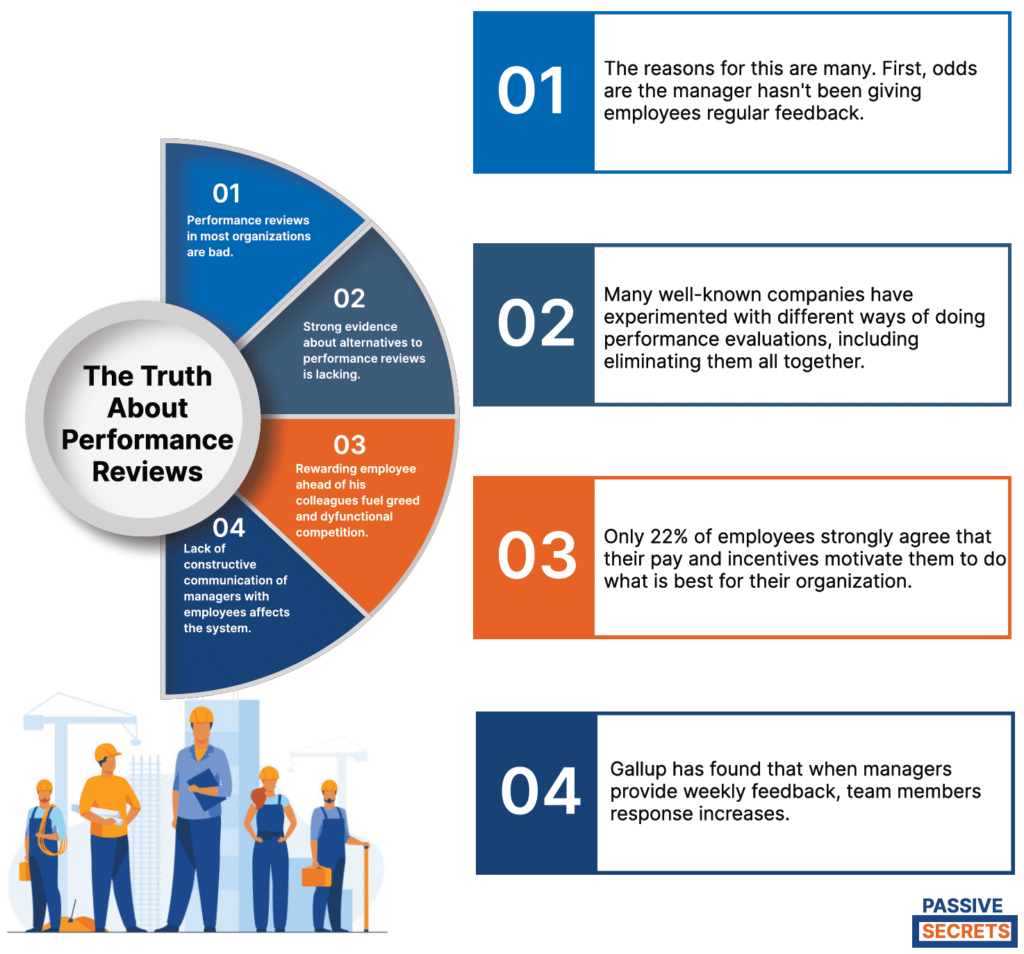
67. Statistics have shown that removing performance ratings can lead to a 4-10% decrease in employee performance. (source)
It remains a crucial process for most organizations in determining the performance of their employees.
68. 36% of HR leaders struggle to maintain accountability regarding DEI (Diversity, Equity, and Inclusivity). Inclusivity has been seen to be a critical metric in determining employees’ performance as of 2021. (source)
Latest Performance Management Trends
Employees’ performance management will keep evolving. If your organization doesn’t keep up with the trends, your organization is on the verge of being lost among other companies.
As a manager or CEO, you must adopt the current trends in performance management. Adopting these trends will help minimize the recent “Great Resignation” rate hovering around various enterprises.
Different trends have evolved in performance management, and your company can use them effectively with proper understanding.
1. Continuous Feedback and Check-ins
Continuous feedback is a better performance management measure than waiting for an annual or bi-annual report.
You are more likely to see progress when feedback is analyzed frequently than when employees wait months for reports and reviews.
Continuous feedback can also help workers stay engaged as they can set and reset goals using the reviews obtained.
The recent trend agrees it’s time to ditch the annual performance reviews and appraisals. However, 65% of employees clarified that they need and want more feedback.
This article is not against annual performance reviews. Instead, it clearly states that continuous feedback and coaching can improve your company’s accountability, transparency, and leadership.
Your employees need to know how well or poorly they are doing. Knowing their performance will help them improve and offer better services to your clients.
You can achieve this with the aid of feedback software.
If, as a manager, you only evaluate employees once a year, you may need help creating an accurate picture of an employee’s performance.
The truth is most employees are involved in several projects now.
Therefore, it is best to document the performance in real-time and always give it out to improve performance.
2. Hybrid Work
Hybrid work is the new normal. 87% of employees say that they want to work from home at least one day of the week.
Employees are looking for more flexible work options and are willing to move in with any organization that offers such flexibility.
Some organizations may argue that hybrid or remote work gives room for a lazy attitude from workers. However, you can capture your employee’s performance with standard procedures and tools.
As an organization, engaging in hybrid work helps improve your employee’s work experience. It also shows you prioritize their health and well-being.
Indeed, managers may need to see how their employees are doing, but with the proper communication channels, it could be a workover.
Several channels exist to achieve and ensure proper communication and feedback, such as Slack and Google Meet.
3. Data-driven Performance in all Aspects
Days are gone when vital company decisions are based on the manager’s gut feeling or biases. Data-driven performances are not just for promotion and compensation.
These data can be effective in assessing performance management.
The data can also unlock talent management among workers in your company. With the data, you can answer the questions:
- What role does employee A work best in?
- What conditions does employee C thrive best in?
- What skills does employee X need to improve on?
For any organization intending to survive competition, making data-driven decisions is the way.
Moreover, these data-driven decisions motivate and encourage employees’ performance.
These performance data can also be effective in career advancement. They can be effective in gap identification in your firm’s competencies.
You fill these gaps through project staffing and planning.
As a manager, analyzing the year-to-year trends in performance management helps you see how everyone is advancing and flowing with the trends.
With the information, you can determine who needs more help adjusting.
4. Use of Specific Key Performance Indicators to Measure Performance
KPIs (Key Performance Indicators) are effective means of measuring performance. These indicators are SMART (Specific, Measurable, Attainable, Reliable, and Time-bound).
They identify, analyze, and track areas of growth and development. The KPIs are not limited to the company’s career advancement or growth. Instead, they stretch to the performance management of the team.
When you set your business’ KPIs and track them, you see how well your employees are doing and how best to help them improve.
With KPIs, the managers and employees can see their progress and the results of their efforts.
5. Provision of an Incentive Plan for Professional Development
It has become an error in various companies when they don’t appreciate loyal workers. These dedicated workers, year after year, feel used without any recognition or incentive added to them.
In worst-case scenarios, they leave the company or perform their assigned task with much grumbling and hatred.
There is nothing wrong or dangerous in appreciating your loyal team members.
However, you must adopt an incentive plan that supports any worker’s professional development to reach career advancement with your company.
These incentive plans encourage them to stay and increase their efforts.
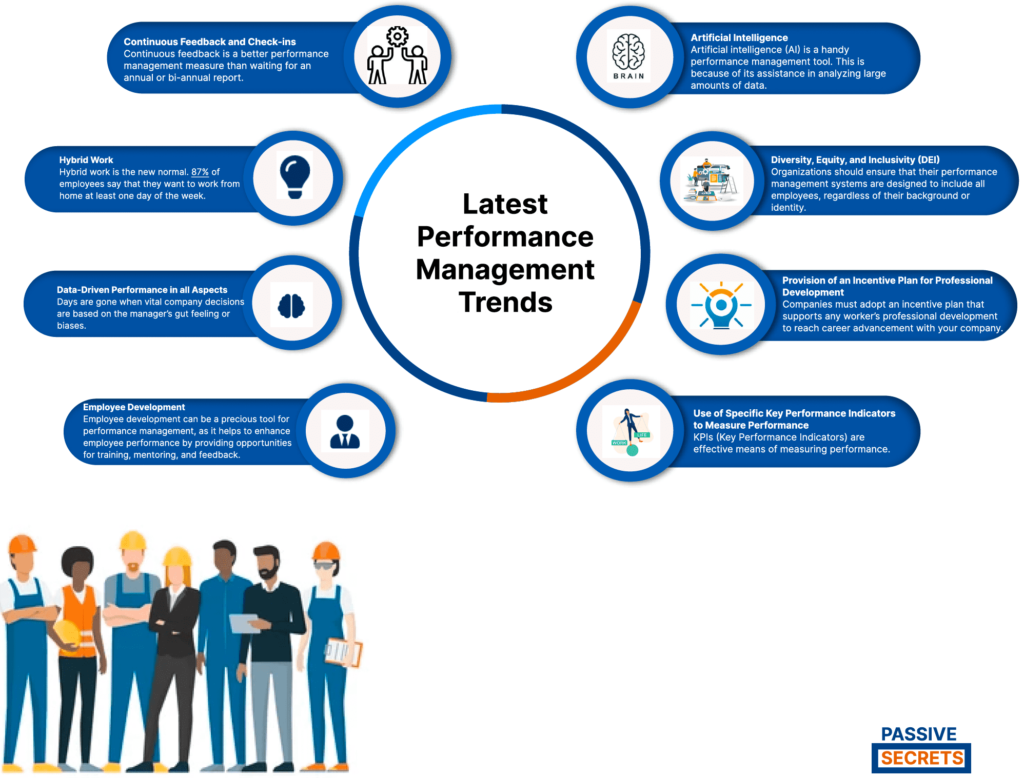
6. Employee Development
Employee development can be a precious tool for performance management, as it helps to enhance employee performance by providing opportunities for training, mentoring, and feedback.
By investing in employee development, organizations can boost employee engagement and motivation, driving better worker performance.
Employee development helps close skill gaps that may be limiting an employee’s performance and fosters a culture of continual learning and improvement.
There are several factors to consider when developing employees;
- The assessment of an employee’s strengths and weaknesses. This would help them tailor their various development programs accordingly.
- Providing opportunities for ongoing feedback and coaching so employees can continue to grow and improve over time.
- Considering employee’s career goals and aspirations. This would help you design the development program to align with those goals.
- Ensuring the development program is relevant to the employee’s current role and responsibilities. This would provide a proper alignment with the organization’s overall goals.
7. Artificial Intelligence
Artificial intelligence (AI) is a handy performance management tool. This is because of its assistance in analyzing large amounts of data.
This data can then provide insights that can inform management decisions.
For example, AI can track employee performance metrics, identify patterns and trends, and predict future performance.
AI can also automate specific tasks, such as scheduling and performance tracking, freeing managers’ time to focus on more strategic tasks.
Furthermore, AI has the potential to revolutionize performance management through the use of AI-powered tools like chatbots, machine learning, and natural language processing.
These technologies can help managers gather and analyze data, identify patterns, and provide real-time feedback to employees.
AI could create more personalized and dynamic performance management systems that adapt to employees’ unique needs and goals.
8. Diversity, Equity, and Inclusivity (DEI)
Diversity, equity, and inclusion (DEI) are essential considerations in any performance management strategy.
Organizations should ensure that their performance management systems are designed to include all employees, regardless of their background or identity.
This means creating a culture of inclusivity, providing training and resources on DEI topics, and ensuring that performance metrics are objective and equitable.
Additionally, organizations should consider how they can use their performance management system to promote and reward diversity, equity, and inclusion within the workplace.
Employers should ensure that their performance goals and metrics are transparent and objective, and that they are not biased towards any particular group of employees.
Equal opportunities can also be provided for employees from diverse backgrounds to receive feedback, recognition, and rewards for their performance.
Finally, performance management tools can be used to measure and track the progress of their DEI initiatives.
Conclusion
The classic era is way beyond us. We now exist in a more modern era, and this involves the inclusion of certain things in work culture.
Performance management is a practice that will keep evolving, and anyone or a company that doesn’t flow with the tide might be cut off from the workforce.
As a company, you must be aware of the rising trends. Therefore, always be on stand to provide your workers with all they need to achieve maximum profitability.
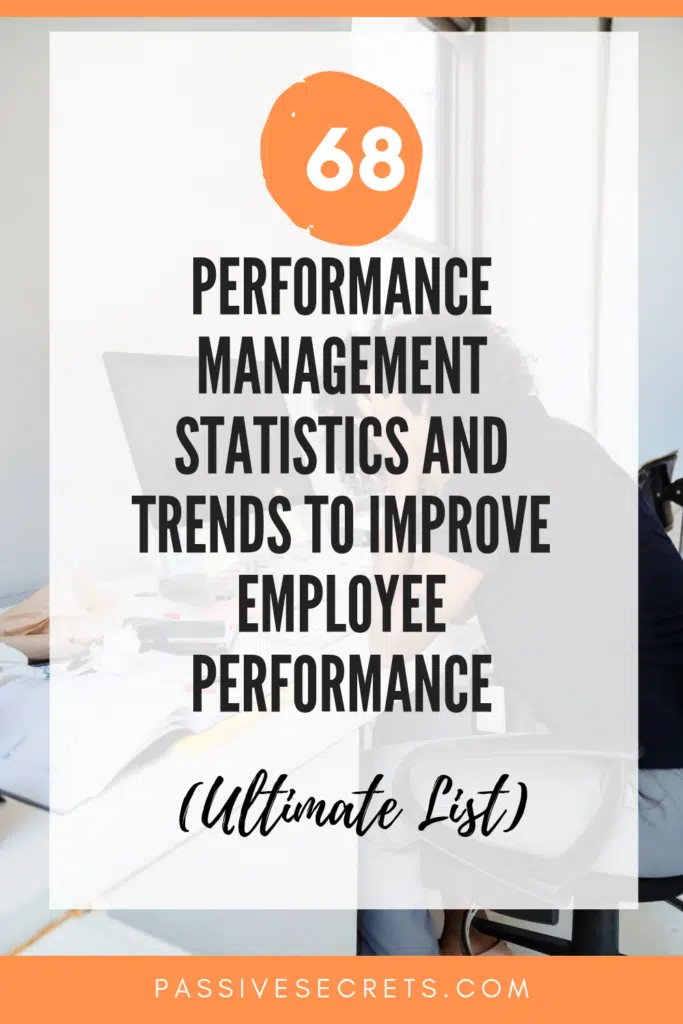
Related Posts:
- 47+ Important 4-day Work Week Statistics [2024]
- 73 Revealing Workplace Distraction Statistics [2024]
- 40+ Top Workplace Conflict Statistics You Should Know In 2024
- 45+ Important Communication Skills Statistics & Trends for 2024
- 25+ Best Emotional Intelligence Statistics to Know in 2024
- 71 Important Workplace Communication Statistics To Know in 2024
- 55 Teamwork & Workplace Collaboration Statistics To Boost Your Employee Performance
- Holiday Spending Statistics: Valentine’s Day, Easter, Thanksgiving, & Christmas
- Spotify Statistics: Latest Report on The Music Streaming Platform
- Amazon Book Sales Statistics: Intriguing Numbers and Facts
- 60+ Helpful Change Management Statistics & Facts To Know
- 50+ Useful Video Game Addiction Statistics, Facts, & Huge Trends
- Internet Dangers Statistics: A Look At The Internet’s Dark Side
- 50+ Vital Internet Safety Statistics & Facts You Must Know
- 70 Exciting Love Statistics And Facts (True Love, Intimacy, Marriage, Dating & Relationships)
- 65+ Impressive Chess Statistics and Facts To Know in 2024
- 40+ Useful Procrastination Statistics To Help You In 2024
- 55+ Useful Black Consumer Spending Statistics (2024 Report)
- 54 Incredible Goal-Setting Statistics To Help You In 2024
- 50+ Call Center Statistics And Big Trends [Latest 2024 Report]
- 20 Crucial Body Language Statistics To Know In 2024
- 35 Important Public Speaking Statistics To Help You in 2024
- 50+ Latest Life Coaching Statistics and Trends in 2024
- 36 Interesting Social Worker Burnout Statistics for 2024
- 110+ Important Social Media Advertising Statistics & Trends To Help You in 2024
- 41+ Best Copywriting Statistics & Trends to Help You in 2024 And Beyond
- 45+ Useful Omnichannel Marketing Statistics, Data, Trends, & Strategies to Boost Sales Results

